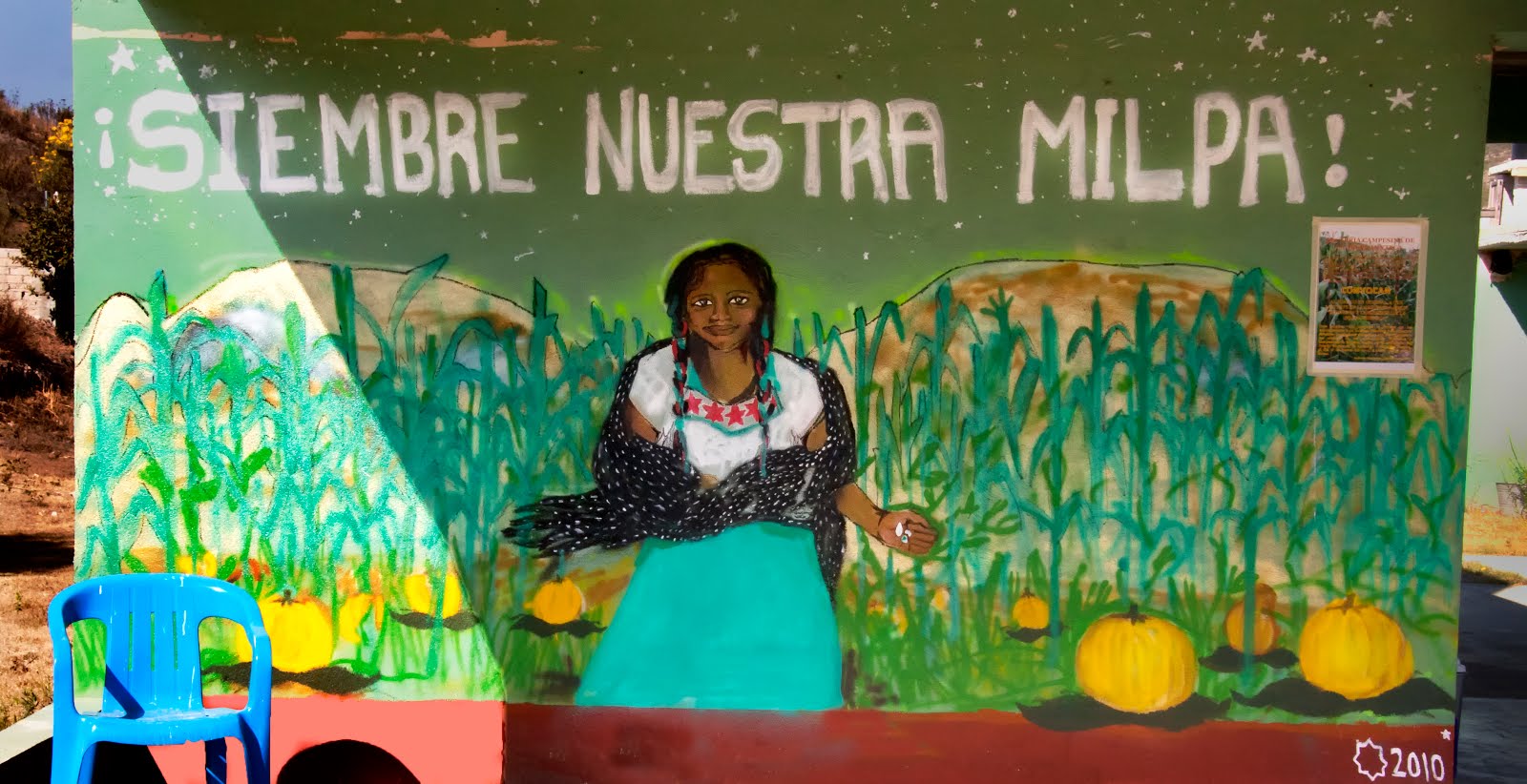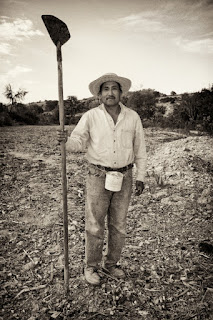MONSANTO APPROACHES, CAMPESINOS UNITE!
April 2012
Dear Friends and Family,
The early “cajete” (ca-háy-tay)
corn, planted when the soil is still dry here in the Mixteca Alta, has sprouted
in the field below the house along with the beans and squash that accompany it
in the milpa. The technique of planting these and other companion plants
together to make up the “milpa” forms an ingeniously productive and
sustainable complex botanical community. Mutual aid, harmony, and equilibrium
hold this community of plants together and make the whole more productive than
when planted separately. And together they form a rich, shady environment in
which dozens of varieties of wild edible and medicinal plants find the unique
conditions for their own growth.
 In spite of the prejudices of the occidental worldview
which proposes that without competition there is no production, in the milpa
we see that the strategy of trying to make one species compete to eliminate
all potential competitors (what is called a monoculture in modern agriculture)
is not more productive.
In spite of the prejudices of the occidental worldview
which proposes that without competition there is no production, in the milpa
we see that the strategy of trying to make one species compete to eliminate
all potential competitors (what is called a monoculture in modern agriculture)
is not more productive.
Today it is becoming evident that in
human communities as well the fierce competitiveness of the occidental vision
is, in the end, much more destructive than productive.
 Last week 300 campesino men
and women from across Oaxaca met in the beautiful ethno-botanical gardens of
Oaxaca City to strategize about promoting and defending the incredibly rich
biodiversity of native corn varieties in this, the center or origin of corn.
More than 36 of the original 56-60 land races of native corn are still planted
here in the mountains of Oaxaca, along with hundreds of varieties of each race,
each adapted to the challenges of the growing conditions of its specific
region. With this incredible biodiversity and these rich genetic resistances we
hold the future of corn on the planet in our hands.
Last week 300 campesino men
and women from across Oaxaca met in the beautiful ethno-botanical gardens of
Oaxaca City to strategize about promoting and defending the incredibly rich
biodiversity of native corn varieties in this, the center or origin of corn.
More than 36 of the original 56-60 land races of native corn are still planted
here in the mountains of Oaxaca, along with hundreds of varieties of each race,
each adapted to the challenges of the growing conditions of its specific
region. With this incredible biodiversity and these rich genetic resistances we
hold the future of corn on the planet in our hands.
Yet, in addition to developing plans
to promote the planting and improvement of native seeds and to strengthen the
custom of planting in milpa in Oaxacan communities, these 300 farmers
needed also a defense plan. Under the “influence” of large international
corporations such as Monsanto, the Mexican government has authorized the very
risky business of planting genetically modified corn in this world center of
origin. The vision of competitiveness that reigns in the dominant cultures
today threatens to destroy access to the world’s sources of corn genetic
diversity through contamination and patenting of native varieties for profit.
Three hundred campesinos this day decided they will fight!
But it is dangerous to fight. Three
weeks ago Bernardo Vasquez, who worked with us on strategies for nonviolent
social change, was killed for his opposition to a Canadian gold mining operation
that is polluting the waters of his community. Two weeks before that Betina,
with whom we have also worked to develop effective strategies to protect
indigenous communal lands, was arrested on trumped up charges. Her opposition to massive private wind
farms that are taking over productive campesino lands on false pretenses, with
the cooperation of the federal government, threatened “progress”. After all, the project is hailed by
foreign environmental groups and receives UN carbon credit payments.

Privately controlled hydroelectric
projects in Oaxaca are inundating thousands of acres of indigenous lands and of
native biodiversity, against international laws that protect indigenous
territories. Indigenous communities are fighting back, while the projects
primarily designed to export electricity for private profit, ironically, receive
carbon sequestration credits.
In a recent interview well known
scientist Amory Lovins of the Rocky Mountain Institute suggested that the
energy needs of the Global North can easily be met by new technological
efficiencies and cheap, clean renewables in a process of conversion from fossil
fuel use led by business for profit. Neither here nor elsewhere in the Global
South do we have the luxury of such faith in the private corporation and the
innocuous character of competitive greed and business for profit.
It no doubt took many years of
careful observation and experimentation for the great, great grandparents of
the Mixtec people to understand and construct the harmonious and productive
community of the milpa. It also seems they carefully studied how to
create harmonious and productive human communities where men and women
complemented one another in producing the material, social and spiritual
necessities of everyone. Some of their wisdom has survived today in our villages’
communitarian organization, which help us produce for the common good: the tequio,
gueza, cargos, and community assemblies.
Like these indigenous ancestors, the
human family of today will have to learn how to form the complex communities of
complementarity, harmony and balanced production that we will need to overcome
the crises we face today. Neither business for profit nor governments beholden
to big money will do it.
©Phil and Kathy Dahl-Bredine, Judith Cooper Haden Photography
 In spite of the prejudices of the occidental worldview
which proposes that without competition there is no production, in the milpa
we see that the strategy of trying to make one species compete to eliminate
all potential competitors (what is called a monoculture in modern agriculture)
is not more productive.
In spite of the prejudices of the occidental worldview
which proposes that without competition there is no production, in the milpa
we see that the strategy of trying to make one species compete to eliminate
all potential competitors (what is called a monoculture in modern agriculture)
is not more productive.  Last week 300 campesino men
and women from across Oaxaca met in the beautiful ethno-botanical gardens of
Oaxaca City to strategize about promoting and defending the incredibly rich
biodiversity of native corn varieties in this, the center or origin of corn.
More than 36 of the original 56-60 land races of native corn are still planted
here in the mountains of Oaxaca, along with hundreds of varieties of each race,
each adapted to the challenges of the growing conditions of its specific
region. With this incredible biodiversity and these rich genetic resistances we
hold the future of corn on the planet in our hands.
Last week 300 campesino men
and women from across Oaxaca met in the beautiful ethno-botanical gardens of
Oaxaca City to strategize about promoting and defending the incredibly rich
biodiversity of native corn varieties in this, the center or origin of corn.
More than 36 of the original 56-60 land races of native corn are still planted
here in the mountains of Oaxaca, along with hundreds of varieties of each race,
each adapted to the challenges of the growing conditions of its specific
region. With this incredible biodiversity and these rich genetic resistances we
hold the future of corn on the planet in our hands. 





































